Abstract
This article presents the X-ray fluorescence and X-ray diffraction analysis results and the granulometric composition of silicon production cyclone dust and its flotation enrichment products. The technology used for the preliminary preparation of cyclone dust before flotation enrichment is presented. The process of fine media flotation should include the careful preparation and reliminary processing of raw materials, otherwise it is difficult to achieve high flotation selectivity. Technological preparation necessarily includes the following stages: preliminary preparation of dust for flotation; repulping of prepared dust; sonochemical treatment of pulp; gravitational separation of sand phase; flotation separation. A structural diagram of the flotation separation technology used for the silicate and carbon phases of cyclone dust has been developed. As a result of this research, the characteristics of cyclone dust have been obtained, allowing us to draw conclusions about the possibility of its flotation processing and further use of the obtained products in the construction industry. The results of a study of carbon in a froth product have also been obtained. Carbon nanotubes have been discovered.
1. Introduction
The production volumes of metallurgical silicon are constantly growing. The world’s leading silicon producer is China, which annually produces about 6.6 million tons (in 2023) [1]. China accounted for 67% of the global silicon production in 2023. Together with Russia, which is responsible for 9% of the global production, China clearly dominates the silicon market.
The energy consumption needed for the production of silicon metal depends on its purity level and can vary between producers. Typical energy consumption values are as follows [2,3]: metallurgical silicon (98 wt.%) for use in alloys: 11–15 kW⋅h/kg; silicon (99.8 wt.%) for the manufacture of ceramics, electronics, silicones, etc.: ~120 kW⋅h/kg; silicon (>99.9999 wt.%) for solar cells: ~50–100 kW⋅h/kg.
The only producers of metallurgical silicon in the Russian Federation are JSC Kremniy and OOO SUAL-Kremniy-Ural, which are part of OK RUSAL. In terms of production volumes and quality of silicon, JSC Kremniy ranks first in Russia. The design capacity of the plant is about 40 thousand tons of silicon per year. The main activity of JSC Kremniy is the production of metallurgical silicon; in addition, this enterprise is the only producer of refined silicon in Russia. The enterprise has its own raw material base—this includes the Cheremshansky quartzite mine, located 500 km to the east of the plant [4,5].
The production of metallurgical grade silicon is accompanied by the formation of a large amount of dust emissions (from 300 to 900 kg per 1 ton of smelted silicon), which contain a significant amount of silica. The environmental hazard caused by waste is determined by many factors, primarily its chemical composition and conditions of interaction with the environment. The most dangerous forms are dust and sludge, as they are dispersed by the wind during storage [6]. The volumes of waste from metallurgical plants in Russia and, in particular, the Irkutsk region are enormous. Most of it is stored in the open air on sludge fields, the area of which is comparable to the production areas (Figure 1), and only a small part of it is processed [7,8,9].
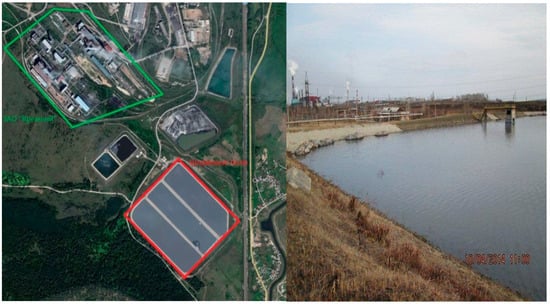
Figure 1.
Slurry fields used during silicon production by JSC Kremniy, Shelekhov, Irkutsk region, Russian Federation (satellite imagery): left—red is a slurry field, green is a factory; right—a slurry field flooded with water.
Reductions in the level of environmental pollution during silicon production by domestic enterprises can be achieved through various measures. These include increasing the percentage of silicon extraction; decreasing the amount of gases and dust subjected to gas cleaning as a result of covering the furnaces with a vault; increasing the efficiency of gas cleaning using dry two-stage cleaning; and reducing the content of sulfur and other harmful impurities in the charge [10,11].
Currently, more than 10 million tons of waste requiring processing have accumulated on the sludge fields of JSC Kremniy [4].
The technological scheme used to obtain metallurgical silicon in ore-smelting furnaces at JSC Kremniy is presented in [12,13,14]. The structure of flows in the furnace complex during silicon smelting is considered in the dissertation [15]. In [16], a simulation mathematical model of the melting of the charge in DC arc steel-making furnaces is presented. In [17], a model of the silicon smelting process, including 15 input-independent parameters, is presented; this, in the opinion of the authors, adequately describes the real technological process as applied to JSC “Silicon”.
Under the conditions of the smelting of silicon-containing charge, the sublimation of silica occurs with the formation of silicon monoxide, which condenses in the upper colder layers of the charge. Part of it is carried by the gas flow to the surface of the furnace throat, where it is oxidized to silicon dioxide and captured by gas cleaning devices [5,18].
The exhaust gases of ore-thermal furnaces contain two types of dust: primary dust, formed from the charge and containing particles of coke, charcoal, quartz, and iron; and secondary dust, formed during the process and during the combustion of partially or completely reduced silicon and other elements. The amount of primary dust, characterized by its lower dispersion, is about 10% of its total content in the gases. The granulometric composition of this dust allows it to be captured in conventional dry and wet cleaning units. A significant proportion (about 90%) is secondary highly dispersed dust, which mainly contains particles of 2 µm in size [19].
The authors of [5] believe that microsilica formation is a consequence of the following processes:
- The interaction between silicon monoxide and carbon monoxide in the gas phase in a furnace at a temperature of 1400–1800 K leads to the formation of microsilica. In low-temperature zones of the furnace, which experience a sharp decrease in both the gas phase temperature and the equilibrium concentration of SiO, disproportionation of silicon monoxide can occur. At very high cooling rates of the gas phase, direct condensation of silicon monoxide is possible. A significant portion of the microsilica formed at this stage is returned to the process.
- In open furnaces, microsilica formation occurs as a result of oxidation.
- Microsilica formation occurs due to mechanical entrainment of small fractions of the charge.
Cyclone dust has previously been found to contain up to 40% carbon [20,21,22]. In this regard, the problem of developing a technology for separating carbon and micro- and nanosilica into two high-purity products—as well as their subsequent use, including in road construction, which requires both micro- and nanosilica for concrete and carbon nanoparticles for asphalt concrete—is relevant [23,24,25,26,27,28,29,30,31]. Amorphous micro- and nanosized silicon dioxide and individual carbon can be valuable products suitable for use as modifiers in ferrous metallurgy [32,33,34] and welding fluxes [35].
The aim of this work is to develop a technology for the enrichment of pulverized silicon production waste to produce two ultrafine products that can be further used in construction and metallurgy as modifiers.
The novelty of the work is the general scheme of enrichment and the use of flotation for pulverized silicon production waste, as well as the development of a new design for an experimental flotation machine with three chambers.
2. Materials and Methods of Research
The materials used in this study were taken from RUSAL silicon factories. A JIB-Z4500 scanning electron microscope provided by JEOL, Tokyo, Japan, was used to examine samples of sludge, froth, and chamber products. The JIB-Z4500 electron microscope has several beams for sample processing (preparation) and observation, and it is equipped with both a scanning electron microscope (hereinafter referred to as SEM), which uses a LaB6 electron gun with high resolution and a long service life, and a focused ion beam device (hereinafter referred to as FIB) with high resolution and high processing speed. The electron optical system (EOS) allows the capture of images with a resolution of at least 2.5 nm at an accelerating voltage of 30 kV in high-vacuum mode, and at least 4.0 nm in low-vacuum mode (1 Pa). The ion optical system (IOS) allows the capture of images with a resolution of at least 5.0 nm at an accelerating voltage of 30 kV and a working distance of 24 mm. In this work, a secondary electron detector, backscattered electrons, and an attachment for micro-X-ray structural analysis were used.
The contrast in secondary electrons depends most strongly on the surface relief, while reflected electrons carry information about the distribution of electron density, with areas enriched in an element with a higher atomic number appearing brighter. Therefore, backscattered electrons, which are generated simultaneously with secondary ones, carry information about the composition of the sample in addition to information about its surface morphology.
For the precise recording of carbon nanoobjects, a transmission electron microscope—the Tecnai G2 20F S-TWIN FEI from the Dutch company FEI (Hillsboro, OR, USA), with an information limit of <0.12 nm and a magnification of 25×–1.000 kx (TEM) 150×–230 Mx (SPEM)—was used. The efficiency of the devices is increased by the presence of EDS analyzers (energy dispersive X-ray spectrometers).
To determine the phase composition, an X-ray diffractometer—the Shimadzu XRD-7000 (Shimadzu, Kyoto, Japan), which is equipped with a high-temperature attachment that allows the study of materials at various temperatures up to 1200 °C—was used.
Sieves conforming to ASTM E11 were used for sieving. Data on the granulometric composition were obtained using the ANALYSETTE 22 NanoTec from FRITSCH (FRITSCH Milling & Sizing, Inc., Pittsboro, NC, USA), a laser device for measuring particle size.
To determine the specific electrical resistance, “tablets” were pressed from the selected dust samples under a pressure of 35 MPa. A conductive coating was applied to the lower and upper surfaces of the “tablet”, to which electrodes were subsequently connected. The measurement was carried out by assessing the magnitude of the current flowing through the sample; the potential difference applied to the electrodes was 30 V.
The specific electrical resistance was calculated using Formula (1):
where I—current flowing through the sample, A; d—sample thickness, m; U—potential difference, V; S—electrode area, m2.
To measure hygroscopicity, open cups with test samples placed in them were placed in a desiccator with distilled water at relative humidity (98 ± 2%) and kept in there for 4 h.
The collapse method was used to measure the static angle of the natural slope. The bulk product was placed in a rectangular container, and then one of the side surfaces was removed. As a result, the mass of the bulk product collapsed, and the angle formed by the slope of the collapsed product and the horizontal was the static angle of the natural slope. The test material was poured into a rectangular box measuring 10 × 20 × 30 mm (or more) so that its free surface was horizontal, and then it was rotated at an angle of 45 or 90°. After the load stopped shedding, the angle of the natural slope was determined using a protractor or by measuring the height h and length L of the slope and calculating the tangent of the angle φ (tg φ = L/h).
The measurement of the dynamic angle of the natural slope consisted of measuring the angle at which the outer surface of the granular material is located when the particles fall on a flat surface. For this purpose, a device with three planes was used, on which angular scales were applied. The material was poured out of the funnel until the tip of the poured powder reached the top of the angle-measuring device.
To carry out the XRF measurements, the samples were placed in a round quartz cuvette and pressed into tablets with a diameter of 25 mm.
Free carbon is determined according to [36].
A 1 L container was used to measure the bulk density. The bulk density was calculated with Formula (2):
where Db—bulk density, M—mass of freely filled powder, V—volume of filled powder.
Db = M/V,
To develop the technology for preliminary processing of silicon production cyclone dust, sieves were used to sift and remove particles larger than 400 µm. Then, a hydroacoustic cavitator was used. Pine oil (0.100 kg/m3) was used as a frother, and kerosene (0.025 kg/m3) as a collector. These were chosen because the goal was to select reagents that were both highly effective and cheap. For this region, pine oil and kerosene are the most affordable, which significantly affects the possibility of introducing this development into production.
After cavitation treatment, the pulp was settled for 15 min to precipitate the most dense and heavy particles (sand phase), then the pulp was pumped into a flotation machine, and the remaining sediment (sand phase) was selected for further study.
The flotation machine’s volume is 0.02 m3, and in this machine there are 3 cleaning chambers. The pulp was pumped into the aerator under a pressure of 0.4 MPa using a pump from cleaning chamber I. Air was sucked into the aerator by a stream of pulp from the atmosphere. The flotation time was 30 min.
3. Results and Discussion
The results of a comprehensive study of silicon production cyclone dust and its main properties, methods of preliminary preparation for flotation enrichment, and the results of transmission microscopy of the obtained products are presented in this section.
3.1. Research of into the Kinetics of Cyclone Dust Flotation
Figure 2 shows the appearance of silicon production cyclone dust.
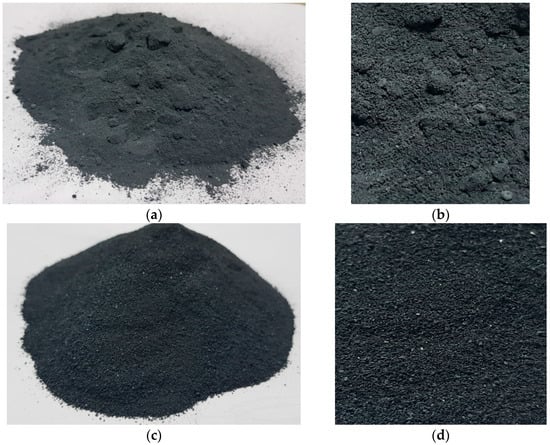
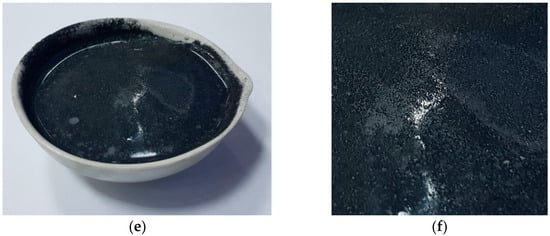
Figure 2.
The appearance of cyclone dust: (a) and (b) original dust; (c) and (d) after sifting; (e) and (f) after soaking in water.
Cyclone dust is a black mechanical mixture consisting of fairly large pieces before sifting and small ones after sifting. We carried out sieving with a 400 µm sieve, after which the larger fractions were thrown away, the rest was soaked. After soaking in water, a black gelatinous mass was formed (Figure 2e,f) with some lumps on the surface.
Figure 3 shows the diffraction pattern of cyclone dust, obtained from X-ray structural analysis.
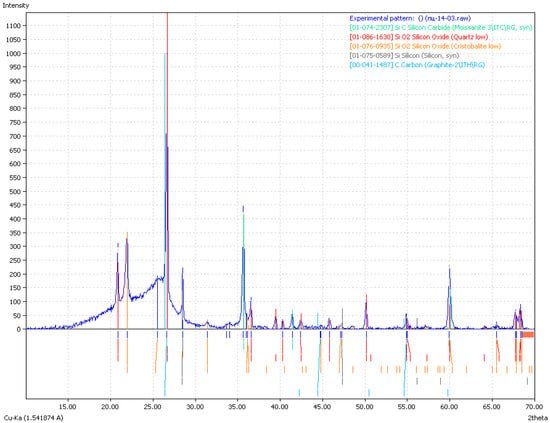
Figure 3.
The diffraction pattern of a cyclone dust sample.
The phase composition of cyclone dust is shown in Figure 3: SiO2 (quartz and cristobalite), SiC (moissanite), C (graphite), Si (silicon). A halo with a maximum intensity in the region of 20 degrees 2theta indicates the presence of amorphous SiO2, and in the region of 26 degrees 2theta, amorphous carbon.
The data from X-ray structural and X-ray fluorescence analysis, as well as analysis by means of SEM, made it possible to establish the average composition of silicon production cyclone dust: SiO2 = 67.37%, C = 23.47%, SiC = 5.03%, CaO = 1.19%, Al2O3 = 0.24%, K2O = 0.24%, Fe2O3 = 0.21%, MgO = 0.059%, Na2O = 0.059%, others—2.132%.

Table 1.
The granulometric composition of cyclone dust.

Figure 4.
The granulometric composition of (a) cyclone dust; (b) cyclone dust before and after sonochemical treatment.
The results of the granulometric measurements of the initial cyclone dust after sieving through a 400 µm sieve show that the particle sizes vary from 0.01 µm to 400 µm. The maximum particle distribution corresponds to 100 µm. The data were obtained using a laser particle size measuring device, ANALYSETTE 22 NanoTec from FRITSCH. The D80 is 86 µm.
As a result of the analysis of the diffraction pattern and the determination of the elemental and granulometric composition, it can be concluded that the cyclone dust mainly consists of amorphous microsized carbon and silicon dioxide with an admixture of silicon carbide. According to the results of the laboratory measurements, it was established that the cyclone dust has the following physical characteristics:
- Hygroscopicity (temperature 24.8 °C, relative humidity 100%) was 16.6%;
- Regarding the static angle of repose, the minimum angle β was 30° and the maximum angle α was 70°;
- Specific electrical resistance was 6.5 × 107 Ohm × m;
- Dynamic angle of repose was 39.3°;
- Bulk density was 680 kg/m3.
3.2. Preliminary Preparation of Cyclone Dust for Flotation Enrichment
This section presents the technology and modes used for the preliminary preparation of cyclone dust for flotation separation [37,38,39,40,41].
The first stage of the preparation of cyclone dust after repulping is sonochemical treatment of the pulp in a cavitation unit. The effect of sonochemical treatment on the granulometric composition of the pulp is shown in Figure 4b.
Sonochemical treatment facilitates the separation of conglomerates, including heterogeneous ones, and better subsequent treatment of the pulp with frothers. The value of the resulting products directly depends on their granulometric composition.
After treatment in a cavitation unit, it is necessary to perform gravity separation of larger particles larger than 50 μm, since they are of no practical value as modifiers. The D80 is 70 µm.
The D80 of cyclone dust is 86, after sonochemical treatment it is 70, and after the removal of the coarse phase it is 50.
Figure 5 shows a diffraction pattern of the coarse dispersed phase removed from cyclone dust. The quantitative composition of the coarse dispersed phase is presented in Table 2.
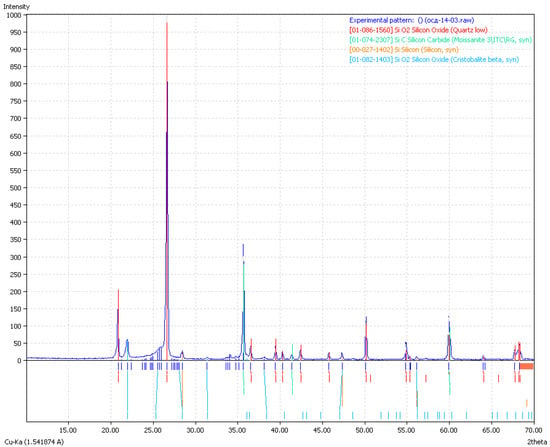
Figure 5.
The diffraction pattern of the coarse phase removed from cyclone dust.

Table 2.
The quantitative composition of the coarse phase removed from cyclone dust.
The diffraction pattern contains narrow intense peaks, which indicates the crystalline structure of the sample under study. The quantitative composition shows that the particles removed from the pulp are represented by crystalline carbide and silicon dioxide.
The cyclone dust has phases including SiO2 (quartz and cristobalite), SiC (moissanite), C (graphite), Si (silicon), and amorphous SiO2. After the coarse phase, which contains SiC (moissanite), SiO2 (quartz), SiO2 (cristobalite), and Si (Crystal), is removed from cyclone dust, the particles remaining in the pulp with a size of less than 50 micrometers are C (graphite) and amorphous SiO2.
Coarse phase product is similar in terms of its properties to ordinary sand. The granulometric composition of the coarse phase is given in Table 3 and Figure 6.

Table 3.
The granulometric composition of the coarse phase removed from cyclone dust.

Figure 6.
The granulometric composition of the coarse phase removed from cyclone dust.
The following characteristics were obtained as a result of the study of the coarse dispersed phase of cyclone dust:
- Phase composition—silicon carbide and crystalline silicon dioxide appeared in approximately equal proportions, with up to 5% crystalline silicon;
- The granulometric composition of the crystalline phase contained particles 20–650 μm in size;
- Up to 20% of the amorphous phase was represented by silicon dioxide with a size of up to 20 μm;
- The d80 was 327 μm.
3.3. Transmission and Electron Microscopy of the Obtained Products
During the conducted research it was experimentally confirmed that silicon production waste contains nanostructured objects in the form of carbon nanotubes and spherical particles of silicon dioxide (Figure 7).

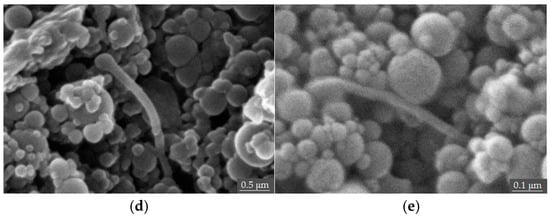
Figure 7.
Electronic photos of nanostructured objects in a chamber product: (a) scale 1 μm; (b) scale 0.5 μm; (c) scale 0.5 μm; (d) scale 0.5 μm; (e) scale 0.1 μm.
More detailed studies conducted by us using high-resolution transmission microscopy allowed us to clarify our information about the nature of the obtained carbon nanotubes. It is well known that a reliable method of fixing carbon nanotubes is via a transmission microscope, since, unlike a scanning electron microscope, it allows the visualization of rolled graphene layers. Scanning electron microscopy (at high magnification of 50,000–100,000 times), shown in Figure 7, gives us the idea that these structural objects have nanometer dimensions. We can see (Figure 8) that the nanoobjects consist of nanoballs (Figure 8a) and tubular rods (Figure 8b). The tubes are filled with a dark substance (black), which allows us to assume another classification of these objects, namely silicon nanorods (tubes).

Figure 8.
Transmission microscopy images of carbon nanoobjects in the froth product: (a) balls with nanotube; (b) nanotubes with balls.
The high-magnification image shows that the nanowires have different morphologies, such as being straight or curved, and the diameters of these nanowires range from 20 to 100 nm. Figure 9 shows the TEM images and surface area electron diffraction (SAED) pattern of the nanostructures, apparently SiC—center of nanotube. As shown in Figure 9a,b, nanowires with different morphologies and a small number of spherical particles were obtained. The diameters and lengths of the nanowires are not uniform. Figure 9b,c shows an individual nanowire. The diameter of the nanowire is about 50 nm, and it is wrapped within a thin amorphous SiO2 shell 1–2 nm thick, which is the surface layer of the nanotube. In addition, a high density of strata is observed in the nanowires. The stripes indicate multiple flat defects, such as stacking faults, perpendicular to the nanowire axis.
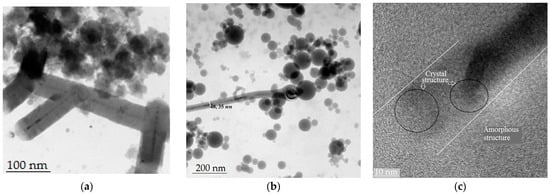
Figure 9.
Silicon nanowires observed in froth and chamber products: (a) scale 100 μm; (b) scale 200 μm; (c) scale 10 μm.
HRTEM and selected area electron diffraction (SAED) analysis were also performed to further investigate the microstructure of these nanowires. Figure 9c shows the HRTEM image of a SiC nanowire and the corresponding high magnification image. These plane defects, marked by light and dark contrast, are nearly periodic twins of the (1 1 1) basal planes. The spacing between adjacent bands is 0.25 nm, just like the spacing between the (1 1 1) plane in β-SiC.
The energy dispersive spectroscopy (EDS) spectrum shown in Figure 10 reveals that the nanowire is mainly composed of Si and C, and a small peak of the oxygen element is also observed. It is well known that SiC has many polytypes, mainly β-SiC (3C-SiC) and α-SiC (2H-SiC, 4H-SiC, and 6H-SiC) [42]. The differences between them lie in the stacking sequences of the basal plane in which the atoms have the closest two-dimensional arrangement.
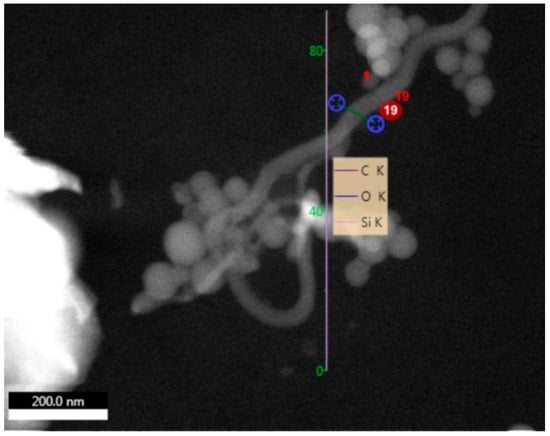
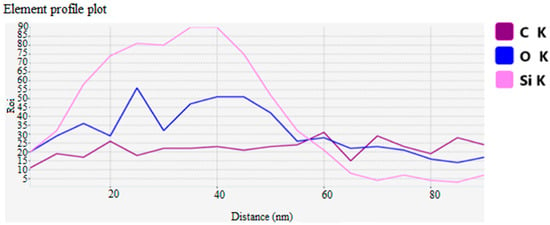
Figure 10.
The distribution of elements across the cross-section of a silicon tube (maximum silicon content in the center, silicon dioxide at the periphery).
Taking 3C-SiC as an example, the stacking sequence of the plane (1 1 1) is (ABC) n-. The vapor–solid reaction of the gas phases of SiO and CO leads to the growth of SiC nanowires due to the growth of screw dislocations.
Since the kinetic conditions are tolerant of high temperatures, the imperfection of the structure can be relaxed by rearranging the atoms to reach a low energy level. The most probable arrangement result is determined by the lowest energy criterion. Only the periodic twisted 3C-SiC nanowire with a hexagonal cross section and {1 1 1} side surface faces can be obtained, since it satisfies the lowest energy criterion.
3.4. A Structural Diagram of the Technology Used for Flotation Separation of the Silicate and Carbon Phases of Cyclone Dust
The preparation process necessarily includes the following stages:
- Preliminary preparation of dust for flotation;
- Repulping of the prepared dust;
- Sonochemical treatment of pulp;
- Gravitational separation of the sand phase;
- Flotation separation.
The flotation separation process itself must take place under certain conditions [43].
It is necessary to maintain a high froth layer in which additional separation will occur. To wash out hydrophilic particles from the froth layer, it is necessary to carry out irrigation of the froth layer.
To meet these conditions, the flotation machine aerator must ensure a consistently small size of flotation bubbles; additional separation of bubbles by size must be carried out in the flotation machine’s working chamber. The separation of bubbles is ensured by pulp circulation in the flotation machine’s working chamber. Circulation also provides additional gravitational forces that act on particles. Froth overflowing from the drain sill flows into a circular shell, from where it is drained for further operations.
The selected flotation separation process flow chart must be tested in laboratory conditions using a real incoming product as an example.
A structural diagram of the flotation separation technology for the silicate and carbon phases of cyclone dust is shown in Figure 11.

Figure 11.
A structural diagram of the flotation separation technology for the silicate and carbon phases of cyclone dust.
The holding time of the pulp in the repulpator depends on the properties of the specific raw material and can last up to several hours. A long holding time is explained by the need to hydrophilize the particles, which are hydrophobic, while their developed surface is not sufficiently wetted.
Sonochemical treatment allows the separation of stable particle conglomerates, thereby increasing the efficiency of flotation. When cavitation bubbles are destroyed, they exert a powerful mechanical effect on the particles in the pulp. This effect leads to the destruction of non-monolithic particles, improving the quality of the product. In addition, as a result of sonochemical activation, the productivity and selectivity of flotation increases.
The initial source sludge was a raw material that was heat-treated at a temperature of 400–600 °C, then crushed to a particle size of no more than 10−6 m. Before flotation separation, it is necessary to remove obviously large particles from the pulp. Any gravity enrichment method is suitable for this. The removed particles, if they are of interest, can be sent to another processing line. Moreover, the processing of these particles can also be carried out by the flotation method, and on the same flotation lines.
The processed sludge was diluted with tap water at a ratio of 10 L of water to 10 L of wet sludge. The resulting pulp was passed through a hydrocyclone in order to remove a small coarse portion. Then the pulp was treated with reagents (frothers and collectors) in a hydroacoustic cavitator. Pine oil (0.100 kg/m3) was used as a frother, and kerosene (0.025 kg/m3) as a collector.
The mixture resulting from the preliminary treatment was fed to a laboratory flotation machine (Figure 12). At pH = 9.5, silicon dioxide and carbon dioxide particles were separated. Tap water was used (central water supply with standard cleaning), reagents were purchased at a hardware store and were labeled according to the standard standards.
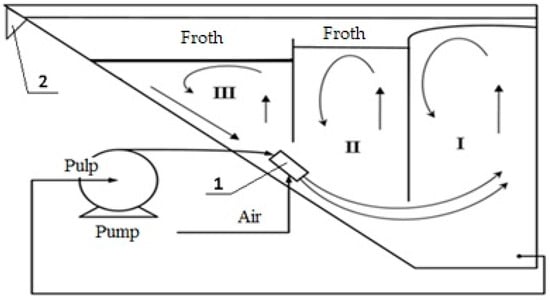
Figure 12.
A scheme of the experimental flotation machine with 3 chambers: 1—pneumatic–hydraulic aerator–ejector, 2—drain sill.
The formation of small flotation bubbles is possible only with the use of pneumatic–hydraulic aerators which, in addition to pulp aeration, perform sonic and ultrasonic pulp treatment during its circulation in the working chamber of the flotation machine.
The working chamber must be able to facilitate a circulation flow of pulp—this will allow the separation of bubbles due to the force of inertia. Pulp aerated with large bubbles, due to its lower density, will concentrate closer to the center of the working chamber. Large bubbles, when floating up, should not fall into the froth heading to the drain sill; accordingly, a partition is needed in the middle of the flotation machine for froth formed by large bubbles. Inside this partition, the froth will self-destruct, and the removed particles will return to the pulp.
The resulting products were as follows: chamber product—silicon dioxide (95%), froth product—carbon nanoparticles (94%).
Preliminary sonochemical treatment allows us to break up particle conglomerates. Further sedimentation and separation of the sand phase allows us to remove large crystalline particles and leave particles of C (graphite) and amorphous SiO2 smaller than 50 µm.
4. Conclusions
This article presents the results of an analysis of the properties of cyclone dust, methods for their determination, and the laboratory equipment used in conducting this research. The article also presents the results of a study of methods for the preliminary preparation of cyclone dust for flotation enrichment.
As a result of the cyclone dust studies, the following characteristics were ascertained:
- Composition: SiO2 = 67.37%, C = 23.47%, SiC = 5.03%, CaO = 1.19%, Al2O3 = 0.24%, K2O = 0.24%, Fe2O3 = 0.21%, MgO = 0.059%, Na2O = 0.059%, others—2.132%;
- Phase composition of cyclone dust: SiO2 (quartz and cristobalite), SiC (moissanite), C (graphite), Si (silicon);
- Granulometric composition of dust after sifting through a 400 μm sieve: particle sizes vary from 0.01 μm to 400 μm, with a maximum particle distribution near 100 μm;
- Bulk density of cyclone dust is 680 kg/m3;
- Dynamic angle of repose is 39.3°;
- Static angle of repose: the minimum angle β was 30°, the maximum angle α was 70°;
- Hygroscopicity at a temperature of 24.8 °C and a relative humidity of 100% was 16.6%;
- Specific electrical resistance: 6.5 × 107 Ohm × m.
As a result of the study of the coarse dispersed phase of cyclone dust, the following characteristics were determined:
- Composition: silicon carbide and crystalline silicon dioxide in approximately equal proportions, with up to 5% crystalline silicon;
- Granulometric composition of crystalline phase: 20–650 μm;
- Up to 20% of the amorphous phase was represented by silicon dioxide, which had a size of up to 20 μm.
The coarse phase of cyclone dust can be used as a raw material for obtaining silicon carbide. To do this, it is necessary to convert silicon dioxide into a soluble salt, and then wash the silicon carbide particles using a filter. This technology is one of the promising areas of further research.
Technological preparation necessarily includes the following stages: preliminary preparation of dust for flotation; repulping of the prepared dust; sonochemical treatment of pulp; gravitational separation of the sand phase; flotation separation.
A structural diagram of the flotation separation technology for the silicate and carbon phases of cyclone dust has been developed.
The results of research into carbon in the froth product have been obtained. Carbon nanotubes have been discovered.
Author Contributions
Conceptualization, A.I.K.; methodology, Y.I.K.; formal analysis, V.A.G.; investigation, A.I.K. and Y.I.K.; data curation, V.A.G.; writing—original draft preparation, A.I.K.; writing—review and editing, Y.I.K.; supervision, V.A.G.; project administration, A.I.K.; visualization, Y.I.K. and V.A.G. All authors have read and agreed to the published version of the manuscript.
Funding
This research was funded by the National Research Moscow State University of Civil Engineering (grant for fundamental and applied scientific research, project no. 13-392/130).
Data Availability Statement
The data presented in this study are available from the corresponding authors upon reasonable request due to internal policy.
Conflicts of Interest
The authors declare no conflicts of interest.
References
- Silicon Production by Country 2024. Available online: https://worldpopulationreview.com/country-rankings/silicon-production-by-country (accessed on 10 January 2025).
- Pizzini, S. Towards solar grade silicon: Challenges and benefits for low cost photovoltaics. Sol. Energy Mater. Sol. Cells 2010, 94, 1528–1533. [Google Scholar] [CrossRef]
- Pizzini, S.; Calligarich, C. On the Effect of Impurities on the Photovoltaic Behavior of Solar-Grade Silicon. J. Electrochem. Soc. 1984, 131, 2128. [Google Scholar] [CrossRef]
- Kondratiev, V.V.; Govorkov, A.S.; Kolosov, A.D.; Gorovoy, V.O.; Karlina, A.I. The development of a test stand for developing technological operation “flotation and separation of MD2. The deposition of nanostructures MD1” produce nanostructures with desired properties. Int. J. Appl. Eng. Res. 2017, 12, 12373–12377. [Google Scholar]
- Protopopov, E.V.; Galevsky, G.V.; Temlyantsev, M.V. The use of technogenic metallurgical waste in silicon carbide technology. Bull. Kuzbass State Technol. Univ. 2014, 4, 103–110. [Google Scholar]
- Burkat, B.C.; Drukarev, V.A. Reduction of Emissions into the Atmosphere at Aluminum Production; St. Petersburg Mining University: St. Petersburg, Russia, 2005; p. 275. [Google Scholar]
- Kondratyev, V.V.; Nemchinova, N.V.; Ivanov, N.A.; Ershov, V.A.; Sysoev, I.A. New technological solutions for processing of silicon and aluminum production wastes. Metallurgist 2013, 5, 92–95. [Google Scholar]
- Rzhechitskiy, E.P.; Kondratyev, V.V. Ecological and economic efficiency of recycling of gas cleaning solutions and fluorocarbon-containing wastes of aluminum production. Ecol. Ind. Russ. 2011, 8, 28–31. [Google Scholar]
- Kondratyev, V.V. Prospects of processing of the solid fluorocarbon-containing wastes of aluminum. Bull. Irkutsk. State Tech. Univ. 2007, 1–2, 36–41. [Google Scholar]
- Nemchinova, N.V.; Mineeva, T.S.; Nikanorov, A.V. Problems of environmental safety of aluminum and silicon production. Mod. Probl. Sci. Educ. 2013, 3, 10–14. [Google Scholar]
- Sivtsov, A.V.; Tsimbalist, M.M.; Fadeev, V.I.; Ostrovskii, Y.I.; Veselovskii, I.A.; Afanas’ev, V.I. Method of controlling the charge feeding conditions in melting of ferrosilicium and ferrosilicochromium. Russ. Met. 2012, 2012, 1036–1040. [Google Scholar] [CrossRef]
- Katkov, O.M. Technology of Technical Silicon Smelting; Kermniy: Irkutsk, Russia, 1999; p. 244. [Google Scholar]
- Elkin, K.S.; Sivtsov, A.V.; Elkin, D.K.; Karlina, A.I. Use of Silicon Carbide Materials in Reduction Smelting of Metallic Silicon and Siliceous Ferroalloys. Metallurgist 2022, 66, 172–179. [Google Scholar] [CrossRef]
- Nemchinova, N.V.; Kritskaya, T.V.; Kolobov, G.A. Study of the impurity composition of silicon of metallurgical grades. Metallurgy 2015, 1, 71–75. [Google Scholar]
- Nehamin, S.M. Creation and Implementation of Energy-Efficient Arc and Slag Electric Furnace Complexes Using Direct Current and Current of Reduced Frequency; National Research University MPEI: Moscow, Russia, 2015; p. 40. [Google Scholar]
- Nehamin, S.M.; Friedman, M.A.; Scherbinin, V.I.; Kotyuk, A.V.; Artemenko, S.A.; Shevchenko, E.V. Smelting of silicon in an orethermal furnace on rectified current. Non-Ferr. Met. 2000, 2, 60–63. [Google Scholar]
- Nemchinova, N.V.; Bychinsky, V.A.; Belsky, S.S.; Kljets, V.E. Basic physico-chemical model of silicon carbothermal melting. Izv. Vuzov. Non-Ferr. Metall. 2008, 4, 56–63. [Google Scholar]
- Yolkin, D.K.; Zelberg, B.I.; Glushkevich, M.I.; Yolkin, K.S. Systems and apparatuses of dry gas purification. Transp. Infrastruct. Sib. Reg. 2015, 1, 244–249. [Google Scholar]
- Lokhova, N.A.; Makarova, I.A.; Patramanskaya, S.V. Roasting Materials Based on Microsilica; Bratsk State University: Bratsk, Russia, 2002; p. 163. [Google Scholar]
- Rassokhin, A.S.; Ponomarev, A.N.; Figovsky, O.L. Silica fumes of different types for high-performance fine-grained concrete. Mag. Civ. Eng. 2018, 78, 151–160. [Google Scholar] [CrossRef]
- Rassokhin, A.S.; Ponomarev, A.N.; Figovsky, O.L. Ultra-light hybrid composite wood-polymer structural materials in construction. Mag. Civ. Eng. 2018, 79, 132–139. [Google Scholar] [CrossRef]
- Ponomarev, A.; Steshenko, D.; Rassokhin, A. Development of technology for production of fire-resistant nanocomposite constructional rebar and structural elements based on it. MATEC Web Conf. 2018, 245, 04001. [Google Scholar] [CrossRef]
- Loos, M. Carbon Nanotube Reinforced Composites: CNT Polymer Science and Technology; William Andrew: Norwich, NY, USA, 2014; p. 304. [Google Scholar]
- Arifuzzaman, M. Polymer nanocomposites for road construction: Investigating the aging performance of polymer and carbon nanotube–modified asphalt binder. In Advanced Polymer Nanocomposites; Woodhead Publishing: Thorston, UK, 2022; pp. 319–334. [Google Scholar]
- Strozzi, M.; Smirnov, V.V.; Pellicano, F.; Kovaleva, M. Nonlocal anisotropic elastic shell model for vibrations of double-walled carbon nanotubes under nonlinear van der Waals interaction forces. Int. J. Non-Linear Mech. 2022, 146, 104172. [Google Scholar] [CrossRef]
- Ghavanloo, E.; Fazelzadeh, S.A. Vibration characteristics of single-walled carbon nanotubes based on an anisotropic elastic shell model including chirality effect. Appl. Math. Model. 2012, 36, 4988–5000. [Google Scholar] [CrossRef]
- Strozzi, M.; Elishakoff, I.E.; Bochicchio, M.; Cocconcelli, M.; Rubini, R.; Radi, E. A Comparison of Shell Theories for Vibration Analysis of Single-Walled Carbon Nanotubes Based on an Anisotropic Elastic Shell Model. Nanomaterials 2023, 13, 1390. [Google Scholar] [CrossRef]
- Rassokhin, A.; Ponomarev, A.; Shambina, S.; Karlina, A. Different types of basalt fibers for disperse reinforcing of fine-grained concrete. Mag. Civ. Eng. 2022, 109, 10913. [Google Scholar]
- Shu, B.; Wu, S.; Pang, L.; Javilla, B. The Utilization of Multiple-Walled Carbon Nanotubes in Polymer Modified Bitumen. Materials 2017, 10, 416. [Google Scholar] [CrossRef] [PubMed]
- Akhnoukh, A.K. Improving Concrete Infrastructure Project Conditions by Mitigating Alkali–Silica Reactivity of Fine Aggregates. Constr. Mater. 2023, 3, 233–243. [Google Scholar] [CrossRef]
- Mohmmad, S.H.; Shakor, P.; Muhammad, J.H.; Hasan, M.F.; Karakouzian, M. Sustainable Alternatives to Cement: Synthesizing Metakaolin-Based Geopolymer Concrete Using Nano-Silica. Constr. Mater. 2023, 3, 276–286. [Google Scholar] [CrossRef]
- Nafees, A.; Javed, M.F.; Khan, S.; Nazir, K.; Farooq, F.; Aslam, F.; Musarat, M.A.; Vatin, N.I. Predictive Modeling of Mechanical Properties of Silica Fume-Based Green Concrete Using Artificial Intelligence Approaches: MLPNN, ANFIS, and GEP. Materials 2021, 14, 7531. [Google Scholar] [CrossRef]
- AlTawaiha, H.; Alhomaidat, F.; Eljufout, T. A Review of the Effect of Nano-Silica on the Mechanical and Durability Properties of Cementitious Composites. Infrastructures 2023, 8, 132. [Google Scholar] [CrossRef]
- Wu, L.; Lu, Z.; Zhuang, C.; Chen, Y.; Hu, R. Mechanical Properties of Nano SiO2 and Carbon Fiber Reinforced Concrete after Exposure to High Temperatures. Materials 2019, 12, 3773. [Google Scholar] [CrossRef] [PubMed]
- Ivanchik, N.N.; Balanovsky, A.E.; Shtayger, M.G.; Sysoev, I.A.; Karlina, A.I. Capability enhancement of production of activating fluxes for arc welding using ultradispersed products of silicon waste processing. IOP Conf. Ser. Mater. Sci. Eng. 2018, 411, 012035. [Google Scholar] [CrossRef]
- GOST 23581.9-79; Iron Ores, Concentrates, Agglomerates and Pellets. Methods of Determination of Carbon Content. RussianGost: Moscow, Russia, 1985.
- Wu, H.; Yang, J.; Zhang, Y.; Xu, L.; Meng, J.; Jin, J. Effects of Spodumene Flotation Tailings on Mechanical Properties of Acid-Based Geopolymer Mortar. Minerals 2023, 13, 150. [Google Scholar] [CrossRef]
- Kondratiev, V.V.; Nebogin, S.A.; Sysoev, I.A.; Gorovoy, V.O.; Karlina, A.I. Description of the test stand for developing of technological operation of nano-dispersed dust preliminary coagulation. Int. J. Appl. Eng. Res. 2017, 12, 12809–12813. [Google Scholar]
- Nemarov, A.A.; Lebedev, N.V.; Kondrat’ev, V.V.; Kornyakov, M.V.; Karlina, A.I. Theoretical and experimental research of parameters of pneumatic aerators and elementary cycle flotation. Int. J. Appl. Eng. Res. 2016, 11, 10222–10226. [Google Scholar]
- Jiang, Y.; Sun, C.; Kou, J. Enhanced Flotation Separation of Iron and Silicon with Branched Block Polyethylene Oxide Polypropylene Oxide and Sodium Oleate: Mechanisms and Flotation Behavior. Minerals 2024, 14, 1081. [Google Scholar] [CrossRef]
- Rulyov, N.N.; Filippov, L.O.; Sadovskyi, D.Y.; Lukianova, V.V.; Filippova, I.V. Reverse Column Flotation of Ultrafine Magnetite Mixture with Fine Glass Beads Enhanced by Fine Bubbles. Minerals 2022, 12, 584. [Google Scholar] [CrossRef]
- Liu, Q.; Wannas, D. The role of polymeric-depressant-induced flocculation in fine particle flotation. In Particle Size Enlargement in Mineral Processing, Proceedings of the UBC-McGill Biennial International Symposium on Fundamentals of Mineral Processing 5th, Hamilton, ON, Canada, 1 August 2004; Canadian Institute of Mining, Metallurgy and Petroleum: Westmount, QC, Canada, 2014; pp. 179–193. [Google Scholar]
- Derjaguin, B.V.; Dukhin, S.S.; Rulyov, N.N. Kinetic Theory of Flotation of Small Particles. Surf. Colloid Sci. 1984, 13, 71–113. [Google Scholar]
Disclaimer/Publisher’s Note: The statements, opinions and data contained in all publications are solely those of the individual author(s) and contributor(s) and not of MDPI and/or the editor(s). MDPI and/or the editor(s) disclaim responsibility for any injury to people or property resulting from any ideas, methods, instructions or products referred to in the content. |
© 2025 by the authors. Licensee MDPI, Basel, Switzerland. This article is an open access article distributed under the terms and conditions of the Creative Commons Attribution (CC BY) license (https://creativecommons.org/licenses/by/4.0/).